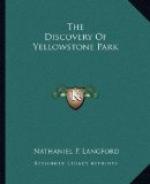The “Grotto,” so named from the singularly winding apertures penetrating the sinter surrounding it, was at rest when we first discovered it. Externally it presented few indications of its character as a geyser. Private Williamson, one of our escort, crawled through an aperture and looked into the discharging orifice. When afterwards, he saw it belching forth a column of boiling water two feet in diameter to the height of sixty feet, and a scalding stream of two hundred square inches flowing from the cavern he had entered a short time before, he said that he felt like one who had narrowly escaped being summarily cooked.
The “Castle” is on the summit of an incrusted elevation. This name was given because of its resemblance to the ruins of some old tower with its broken down turrets. The silicious sinter composing the formation surrounding it takes the form of small globules, resembling a ripe cauliflower, and the massive nodules indicate that at some former period the flow of water must have been much larger than at present. The jet is sixty feet high by four feet in diameter, and the vent near it, which is in angry ebullition during the eruption, constantly flows with boiling water.
One of the most wonderful of the springs in this basin is that of ultra-marine hue directly in front of the “Castle” geyser. It is nearly round, having diameters of about twenty and twenty-five feet, the sides being corrugated and funnel-shaped, and at the depth of thirty feet opening out into a cavern of unfathomable depth, the rim of the spring having beautifully escalloped edges. It does not boil over, but a very small stream of water flows from it, and it is not affected in its appearance by the spouting of the geyser in its immediate proximity. There is evidently no connection between this spring and the geyser.
The “Giant” is a rugged deposit presenting in form a miniature model of the Colosseum. It has an opening three feet in diameter. A remarkable characteristic of this geyser is the duration of its discharges, which yesterday afternoon continued for more than an hour in a steady stream about three feet in diameter and one hundred and forty feet high.
Opposite our camp, on the east side of the Firehole river, is a symmetrical cone resembling an old-fashioned straw beehive with the top cut off. It is about five feet in diameter at its base, with an irregular oval-shaped orifice having escalloped edges, and of twenty-four by thirty-six inches interior diameter. No one supposed that it was a geyser, and until this morning, among so many wonders, it had escaped a second notice. Suddenly, while we were at breakfast this morning, a column of water shot from it, which by quite accurate triangular measurement proved to be two hundred and nineteen feet in height. Our method of triangulation was as follows: A point on the surface of the ground was marked, which was in a direct line with a branch of a tree near by, and of the top of the column of water when at its greatest height. Having obtained the perpendicular height of the branch of the tree from the ground, and the distance from this perpendicular to the point of observation and to the geyser cone, we were enabled to make a very accurate calculation of the height of the column of water. We named this geyser the “Bee Hive.”




